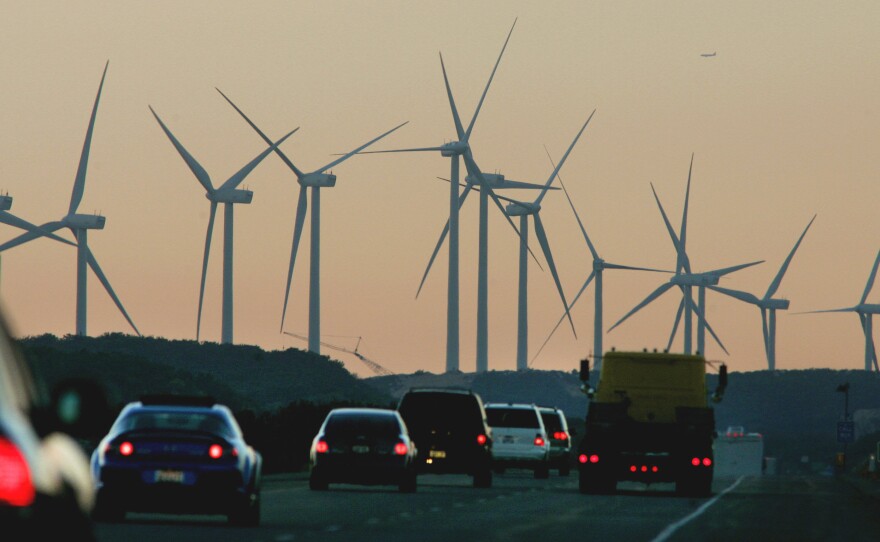This is part two in a series explaining San Diego's Climate Action Plan. The first part can be read here.
San Diego Mayor Kevin Faulconer’s Climate Action Plan calls for many changes to the way we live day to day — everything from reducing car use to boosting recycling. But one of its biggest goals is making the city's electrical grid use only renewable energy by 2035.
Renewable energy means power that comes from sources that don’t deplete over time, including solar power, wind power and hydro power. These are considered better sources of electricity because they're sustainable and cleaner.
SDG&E’s 2014 Power Mix
Renewable: 32%
• Biomass and waste: 2%
• Geothermal: 0%
• Small hydroelectric: 0%
• Solar: 15%
• Wind: 15%
• Coal: 0%
• Large hydroelectric: 0%
• Natural gas: 52%
• Nuclear: 0%
• Oil: 0%
• Unspecified: 16% (electricity from transactions that are not traceable to specific generation sources)
Source: Preliminary numbers from SDG&E
Right now, San Diego Gas & Electric provides San Diego's power. The utility says 32 percent of its energy is renewable.
Getting to 100 percent would likely involve something with the bulky name “community choice aggregation.” But what is it?
"Community choice aggregation is the name of an alternative energy program," said Ty Tosdal, a lawyer who helped Marin County with its community choice aggregation program. "That program is similar to a utility in that it serves residents and businesses, but the similarities stop there. It is not for profit, it is overseen by local government, and it is completely optional for customers, so if a customer does not want to participate in the program they can go with the utility."
Marin and Sonoma counties have set up community choice programs, and the city of Lancaster in Los Angeles County is working toward it. San Francisco's mayor also recently called for setting up a program.
Across the country, 5 percent of residents get their power through community choice aggregation programs.
Right now, your power comes through SDG&E’s electrical grid. SDG&E buys the electricity from a variety of sources, including natural gas plants, hydroelectric dams and wind turbine farms.
If the city goes with community choice aggregation, or CCA, its power would still go through SDG&E’s grid, but the city would buy the energy, not the utility.
"The CCA programs do not actually deliver the power," Tosdal said. "That function stays with the utility. The CCA program buys the power, interacts with customers who choose to participate, and then the power is still delivered by the utility."
The idea is to give the city more control over where the power comes from, which would help achieve its goal of getting all energy from renewable sources by 2035, he said.
"If the city sets a goal like that, it has no ability to require the utility to play along and achieve that goal," he said. "The CCA program can help advance that goal."
Under community choice programs, utility customers decide where their energy comes from. Residents can choose a plan that uses only renewable energy, which might cost more, or a plan that costs less and uses less renewable energy. Or customers can opt out of the program all together and stick with SDG&E.
Amber Albrecht, a spokeswoman for SDG&E, said in a statement that the utility “supports a customer’s right to choose its electricity service provider, including community choice aggregation.”
"SDG&E will fully cooperate with potential CCAs by providing information consistent with the CCA Code of Conduct, state law, and SDG&E’s CPUC-approved tariffs,” the statement said.
By state law, SDG&E isn’t allowed to lobby against community choice aggregation programs.
But Nicole Capretz is still preparing for a fight over it. She heads the nonprofit Climate Action Campaign to act as a watchdog over the city’s climate action plan. The original version of the plan, which she wrote for City Councilman Todd Gloria, said community choice aggregation would be used to get to 100 percent renewable energy. In Faulconer’s version of the plan, it says “community choice aggregation or another program.”
Capretz said she doesn’t think another program would work.
"From what I can see, the city needs to have full control over the solution to get us to 100 percent renewable energy, and community choice energy is really the only policy platform that allows us to have that control," she said.
In January, Faulconer told KPBS Evening Edition that he’s going to look at all the options for getting to that 100 percent goal.
“We put all options on the table because it’s important we achieve that goal,” he said.
In the next year, we’ll find out what those other options might be and whether San Diego’s elected officials will support community choice aggregation.
A study on whether the program would work in San Diego and how much it would cost will be released this month. Then the City Council can decide whether to go forward with it.






